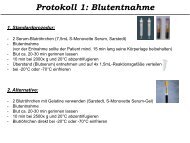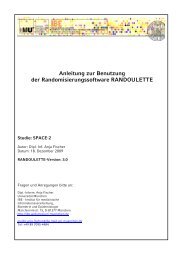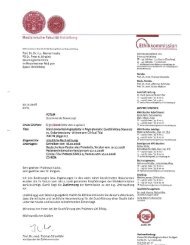CLINICAL TRIAL PROTOCOL SPACE 2 Stent ... - SPACE-2 Studie
CLINICAL TRIAL PROTOCOL SPACE 2 Stent ... - SPACE-2 Studie
CLINICAL TRIAL PROTOCOL SPACE 2 Stent ... - SPACE-2 Studie
You also want an ePaper? Increase the reach of your titles
YUMPU automatically turns print PDFs into web optimized ePapers that Google loves.
Clinical Trial Code: <strong>SPACE</strong> 2 Version: 10. October 2008 Final<br />
Initiative (EUSI) Recommendations for Stroke Management support this and suggest<br />
that CAS is not routinely recommended for patients with asymptomatic carotid stenosis.<br />
It should be considered in the context of randomized clinical trials only [17].<br />
The results of this trial are expected to be the base for defining a proven standard for<br />
the treatment of asymptomatic carotid artery stenosis and would have wide impact on<br />
managing this disease.<br />
1.3 Benefit / risk assessment<br />
The benefit from every treatment modality is the proposed reduction of future cerebroand<br />
also cardiovascular events. However, each treatment arm carries specific risks.<br />
Risks from the conservative treatment are mainly due to possible side effects of the<br />
used medication. Most feared risk of both CAS and CEA is the risk of periprocedural<br />
stroke. Differences between the risk of CAS and CEA are based on technical details.<br />
CEA is usually performed under general anesthesia, which might contribute to the<br />
procedure related complication rate, up to now only a few centers offer local anesthesia<br />
as an alternative. In contrast CAS is generally performed under local anesthesia,<br />
general anesthesia is only required in patients with poor cooperation. CAS always<br />
needs interventional angiography, which increases the risk of stroke by 0.1–0.3% [6].<br />
Current experience suggests that CAS without embolic protection devices causes more<br />
microembolic events than does CEA and these events seem to be associated with an<br />
increased risk of postinterventional DWI lesions, however the clinical impact of these<br />
lesions is still under discussion [12]. Although CAS causes fewer cranial nerve lesions,<br />
it might be associated with more-frequent restenoses than CEA.<br />
To minimize these risks every individual in the trial will be treated by named experts and<br />
a close monitoring for such events will be done. In addition both endarterectomy and<br />
stenting will be done only be certified physicians with a high level expertise and<br />
continuous quality control. For any treatment modality quality committees are defined.<br />
These committees define the rules for the treatment and the quality control criteria (see<br />
Appendix).<br />
2 <strong>TRIAL</strong> OBJECTIVES AND ENDPOINTS<br />
2.1 General aim / primary objective<br />
The objective of this study is to compare up-to-date medical (conservative) treatment<br />
including life-style modification with carotid artery stenting and carotid endarterectomy in<br />
_______________________________________________________________________________________________________<br />
Page 13 of 49





